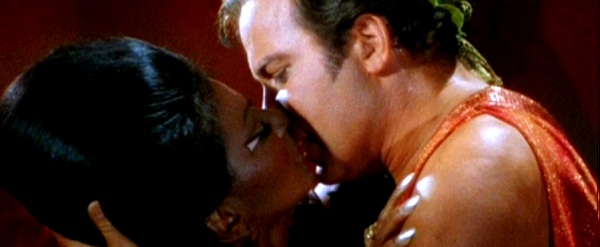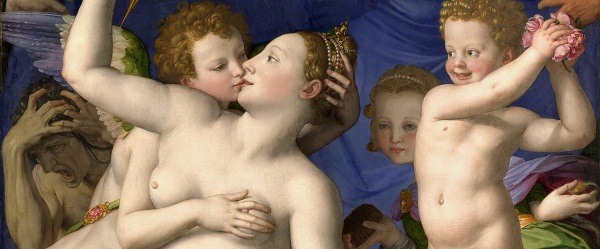
Everything You Ever Wanted To Know About Kissing
Commentary, Cultureby Chris Rhyss
What’s in a kiss?
This question has plagued mankind for eons, and it’s recently become my obsession after I received a virtual kiss just days after venturing into the much maligned world of online dating. Zebra Girl (name withheld because I hope to kiss her again) had found my profile on a dating site and boldly sent me a virtual kiss which soon led to a virtual courting period that spanned email, SMS and various social media channels. A handful of days after virtually meeting we took the plunge and arranged to meet offline, at which point I was overcome with an almost overwhelming urge to kiss her. So kiss we did.
The days between when I had my (fingers crossed) last-first-kiss and our next kiss had me pondering on any number of occasions why I had such a strong compulsion to kiss her. Yes, she was and remains beautiful, but why was I overcome with such a deep-seeded compulsion that our lips meet? Try as hard as I might I couldn’t answer the question, so I did what any confused man does these days – I Googled it! What I have since learned has changed my life.
Just about every culture on the planet kisses, however, I discovered that the contemporary popularity of kissing that we blithely witness on street corners, on television and in gossip magazines every day in Western culture is a fairly recent development. From a historical standpoint, it wasn’t that long ago that our modern predilection for public displays of affection would have been viewed as borderline heresy.
Anthropologists suggest that the very first acts of kissing – circa. 250 thousand years ago when Homo sapiens evolved in Africa – was likely an act that originated to ensure the survival of our species. According to some researchers, mothers may have fed their babies in much the way that birds do; by chewing food and passing it from their mouths to their babies’ mouths. This simple survival strategy, which may or may not have been complimented by a mothers kiss on her infants lips as reward for eating, was then passed down from generation to generation.
Skip forward to ancient Greece and kissing had transmogrified from being a rudimentary survival skill to an accepted social custom associated with affection. Parents openly kissed their children, statesmen lavished congratulatory kisses on their peer’s cheeks, and Homer penned epic works describing incidence of kissing – such as the famed account of King Priam kissing Achilles’ feet to beg for his son’s body.
Jump forward a few hundred years and the Romans have taken kissing to a whole new level. Through their military conquests they had introduced the kiss to other parts of the world, whilst on the home front kissing laws were instituted, designed to institutionalize and popularize this much-valued social custom. In Rome, kisses were used like handshakes to seal legal and business agreements, leading to the famed practice of sealing letters and documents with a kiss (hence the term “sealed with a kiss”).
*More importantly, it’s the Romans we can thank for being the first to popularize the practice of publicly acknowledging a love interest without fear of reprisal. They brought the world a tradition we still revere at weddings today – couples announcing their wedding by kissing passionately in public.
In the third century A.D., kissing finally became associated with physical love, facilitated by the publication of the Kama Sutra which included an entire chapter describing ways of kissing a lover. Soon thereafter, in the Middle Ages, kissing became further popularized as a social gesture for the upper classes who considered it a sign of refinement to engage in (non-heretical) PDA.
Throughout the Middle Ages, kissing grew in popularity amongst the upper classes, principally through the popular practices of people kissing the King’s ring, pressing their lips against the Pope’s ring, or knights receiving kisses from maidens they had jousted for. But as the popularity of kissing and Christianity grew, the church became concerned about the practice of kissing, worried that kissing within the upper classes may encourage carnal sin, or worse, become a popular custom within the lower classes.
In the late 1800’s Charles Darwin theorized that the popularity of kissing amongst the world’s human population must be rooted in our evolutionary past, fueled by an innate desire within our species to connect this way. He surmised the popularity of kissing was influenced by unique social norms and customs, which a few short years later prompted Thomas Edison to release the film “The Kiss” in 1896, a short film which featured the first kiss ever on film. The movie was considered scandalous (at first).

“The Kiss” depicts a re-enactment of the kiss between May Irwin and John Rice from the final scene of the stage musical, The Widow Jones.
Thankfully today, most cultures around the world kiss, but there remain varying, though thankfully shifting, views on the appropriateness of kissing in society and in the popular media. For example, in the late 1960’s, the creators of Star Trek enraged a portion of the populace when characters Uhura and Captain Kirk shared the first interracial kiss shown on television. Years later, in 1991, the creators of LA Law came under attack after airing an episode featuring the first ever lesbian kiss on television, between Amanda Donohoe and Michelle Green.
Even in recent years, kissing creates controversy for varying reasons. In the mid ‘90s, young people in Japan created scandal when they began kissing publicly in a culture that viewed kissing as such a private activity that Rodin’s sculpture, The Kiss, was not displayed in Japan until after the Pacific War. More recently, gay rights advocates in the United States crowded Washington’s National Mall to participate in a ‘peaceful national smooch’ at the Washington Kiss-In. Needless to say, some public outcry ensued.
Today, kissing has evolved from being a mere cultural tradition to a mainstream display of intimacy.
This now common act, of what was once borderline heresy, is now commonly viewed as a harmless part of growing up. It’s become custom for teenagers to kiss as part of their sexual development, yet for adults, the act of kissing becomes even more. It evolves from being exploratory and norm formative to being an important expression of love and erotic emotions in adult relationships.
Most people look forward to their first romantic kiss and remember it for the rest of their lives, but for some, the first truly romantic and intimate kiss doesn’t happen in their developmental years, rather in their adult years when their understanding of romance and intimacy are more fully formed. The oft-used expression that ‘a kiss is just a kiss till you find the one you love’ expresses this most succinctly.
But even armed with this historical context, what is this thing we call a kiss?
The Anatomy of a Kiss
From a biomechanical viewpoint, a kiss is the combined result of your orbicularis oris (the muscle which runs around the outside of your mouth and puckers your lips) working in tandem with the zygomaticus major, zygomaticus minor and levator labii superioris to move your upper lip, the depressor labii inferioris and depressor anguli oris to move your lower lip, your lateral pterygoid to open your mouth, as well as your massiter, temporalis and medial pterygoid to close your mouth.
*In addition, if you’re feeling especially adventurous (dare I say French), this also involves your genioglossus, styloglossus, palatoglossus and hyoglossus to move your tongue.
But the kiss becomes more complex when we move beyond the mechanical to the neurophysiologic. To an Osculologist, a scientist whose career is solely focused on the study of Philematology (the science of kissing), kissing is viewed from a biological perspective, which studies, among other things, pheromones and the chemicals released in the brain while kissing.
To an Osculologist, the kiss is the body’s response to a biomechanical act in which the body reacts by flushing our systems with hormones and natural endorphins. Hormones such as Oxytocin (linked to feelings of attachment and affection), Dopamine (which processes the brains’ emotions such as pleasure and pain), and Serotonin (which affects a person’s mood and feelings) are released. Then, in response to this chemical assault, we experience euphoria as our heart rate increases, our blood vessels dilate, and our bodies receive more oxygen.
Now when viewed from this reductionist perspective, a kiss is little more than a mechanical and chemical response which leads to an experience of euphoria, but ask anyone who has really been kissed and I doubt many would describe the act with references to muscles and chemicals. Clearly a kiss cannot be reduced in such a strict scientific manner.
So if science cannot sufficiently answer the question what’s in a kiss, who can?
To describe a kiss, the act and experience of kissing, it may be more relevant and palatable to the human condition to turn to those more famous for describing such an elusive and ephemeral act; poets and artists. Romantic writers and poets are well known for rhapsodizing on the power of the kiss; to this elite cadre of wordsmiths, kissing is a transformative and essential aspect of our species’ existence.
When Percy Bysshe Shelley, one of the major English Romantic poets, writes of kissing in his famed work Prometheus Unbound, he describes it as ‘soul meets soul on lovers’ lips.’ English poet and playwright Robert Browning supports this depiction of kissing as mystical, penning ‘What of soul was left, I wonder, when the kissing had to stop?’ Sure, these words are inspiring and beautifully written, but to be honest, they only muddy the already murky waters on my search for a clear answer to the question what’s in a kiss?
As my Google search for a definitive answer neared its end, I feared that my days of studying history, science and romantic literature for an answer to my question had been all for naught, but then it hit me. The answer to the question may well lie in an amalgamation of historical and cultural views on kissing, combined with the reductionist scientific and contemporary poetic view of the kiss.
But how to prove it?
It turns out the answer was right in front of me all along, lounging elegantly on a couch whilst Maroon 5’s song Moves Like Jagger played in the background. With thankfully minor encouragement, Zebra Girl agreed to participate in my scientific experiment, so we kissed and I took mental notes. As our lips met I was finally conscious of all that a kiss is, my orbicularis oris moving my lips, the dopamine flooding my system and causing my euphoria, all adding up to me being, in Maroon 5’s words, ‘kissed drunk.’
As it turns out, the answer to what’s in a kiss? is different things to different people:
- To the scientist, it’s muscles and chemicals fulfilling their genetic promise.
- To cultural anthropologists it’s a learned custom that aids our species propagation.
- To teenagers, it’s an eagerly anticipated – and at times overwhelming – rite of passage.
- To poets, it’s a popular topic for penning prose in an attempt to elevate mankind’s spirits.
- But to me and Zebra Girl, it’s an intimate expression of our like / lust / love for each other.
And that’s more than enough answer for me.























